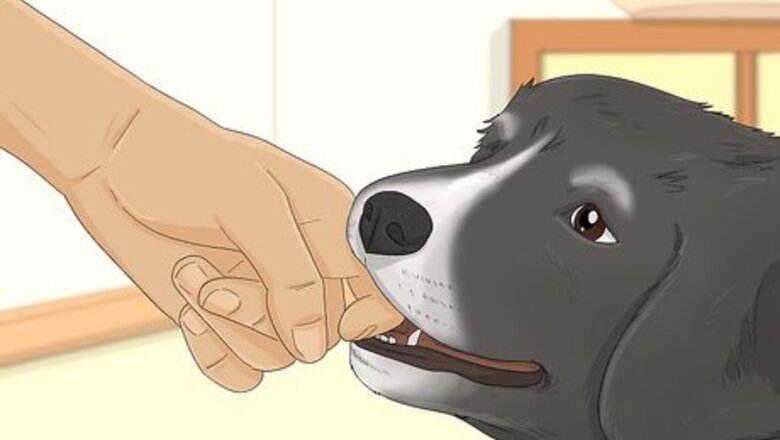
views
Teaching your Dog Bite Inhibition
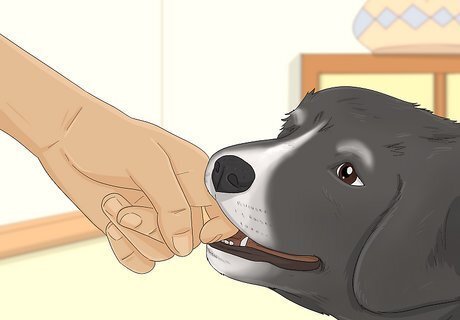
Let your dog mouth your hand. To help teach your dog bite inhibition, you will have to show them that bites are painful. Let the dog play with your hand, and when they bite too hard, make a sharp yelping noise. You may also say something like “That was bad” or “No” in a stern voice. When the dog stops biting you, praise the dog. Only do this activity in brief spurts in a short period of time. You should not let the dog nip more than three times in fifteen minutes. After fifteen minutes are up, end the activity. To teach your dog that biting (even play biting) hurts you or makes you sad, you can also yelp or cry out loudly when he does it.

Put the dog in time out. Once you have started teaching the dog that biting can hurt, you should start “doggy time out.” If the dog nips you or your clothing, say “ouch” sharply. Stand up abruptly and walk away out of the room. Do not play with your dog again until they have calmed down. If you do this every time they nip you, they will learn that it is unacceptable to bite or mouth you.

Spray taste detergent on your hands and clothes. A taste deterrent is an edible spray that tastes bad to dogs, and it can discourage the dog from nipping you or your clothing. You can apply this spray to your clothing and skin for up to two weeks. If you do not want to put it on your bare hands, spray a pair of cotton gloves and wear those while you play with your dog. You can buy taste deterrents that are safe to use on dogs from your vet or local pet store. Some common taste deterrents include: Grannick’s Bitter Apple Spray or Gel Veterinarian’s Best Bitter Cherry Spray Bitter YUCK! No Chew Spray Nature’s Miracle No-Chew Bitter Dog Spray Apple cider vinegar A homemade version made from cayenne pepper and petroleum jelly
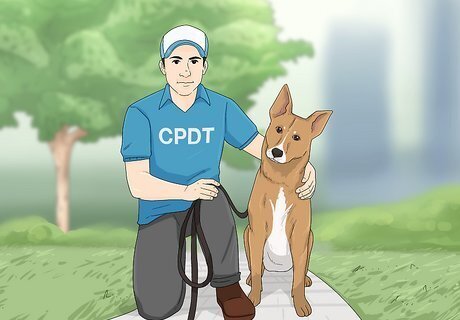
Hire a certified professional dog trainer. If you are having difficulty training your dog yourself, you may have to call a certified professional dog trainer (CPDT) or behaviorist. They may be able to identify what is and is not working with your training regimen, and they can train your dog according to their unique needs. You can find a CPDT through the The Certification Council for Professional Dog Trainers or the The Association of Professional Dog Trainers. CPDTs often offer both group classes and individual sessions.
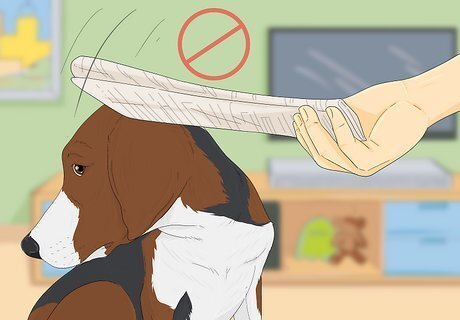
Avoid hitting the dog when they play-bite. Hitting your dog when they nip you may only cause the behavior to worsen. The dog may react defensively or aggressively towards you. They also become shy around humans or start to cower when somebody moves their hand. The best way to train a dog is by rewarding their good behavior. Ignoring the dog by walking away or giving them dog a verbal cue like “no” can also help instill good behavior in the dog.
Fulfilling Their Urge to Chew and Nip
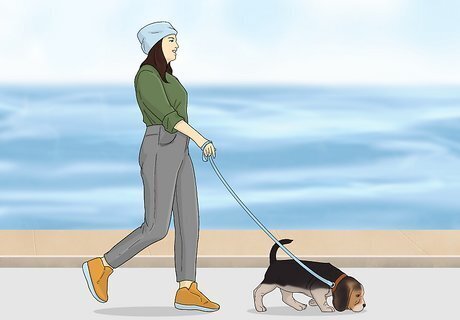
Exercise the dog. A dog that has plenty of exercise is less likely to become overexcited during play, and they are less likely to nip out of boredom. Make sure to take your dog on walks once or twice a day. Give them plenty of time outside, and consider taking them to a dog park where they can play with other dogs.

Give the dog a chew toy when they start to nip. If the dog starts to mouth your hand, give them something acceptable to chew, such as a chew toy, KONG toy, or rawhide bone. Do this every time you think they are about to take someone’s hand or body part into their mouth. If you are nervous about the dog nipping children as they pet the dog, you can give the dog a toy before letting the children come near the dog. Pay close attention no matter what because some dogs and puppies can get aggressive about their toys and they may act out or nip the child.

Encourage non-contact play. Dogs naturally want to nip and mouth people when playing contact games like wrestling or chasing. To prevent the dog from nipping you while playing, try games where you and the dog are not touching. These games include fetch, find the toy, or tug-of-war.
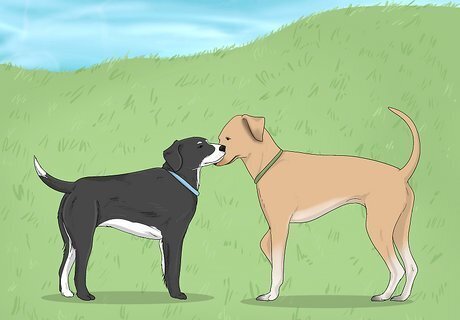
Arrange play dates for your dog. Proper socialization with other dogs can help teach your dog what is and is not appropriate behavior. Letting your dog play with other, non-aggressive dogs will not only teach them proper play but it will let them get out their natural nipping tendencies without injuring you. Try to find a dog that has a similar temperament to your dog and who is roughly the same size. Once they have learned how to safely play with individual dogs, you may want to take them a dog park to see how they fare with a group of unknown dogs.

Avoid waving your hands around their face. When playing with the dog, try not to wave your hands or feet around their face. Doing this might signal to the dog that your limbs are toys. Instead, keep your hands behind their heads while playing.
Reducing Aggressive Play with Other Dogs
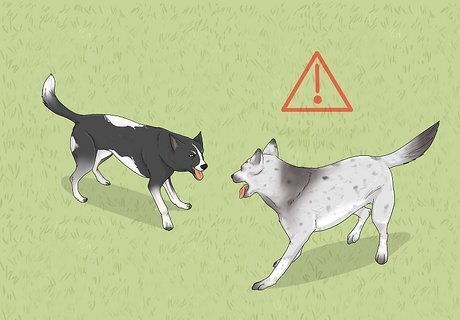
Distinguish between aggression and playfulness. Just because play is rough does not mean that dogs are hurting each other. Dogs often enjoy and benefit from wild play. Watch their body language to see if they are becoming aggressive. Sign of aggressive play include tense facial muscles, a stiff posture, ears pricked forward, tail extended back, and raised fur on their backs. Dogs may also snarl or bare their teeth at the other dog. If this occurs, you should try to separate the dogs. If the dog bows or rolls over, they are likely just playing, and you do not need to separate them. They may also crash into one another, nip, jump onto one another, lightly growl or bark, and chase each other. These are all normal behaviors. Dogs growl while playing, but if the growl suddenly drops to a lower tone, they may be becoming aggressive.
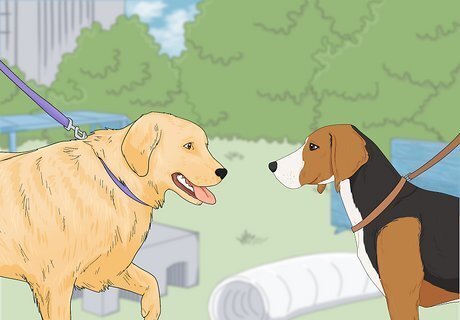
Introduce dogs on neutral ground. Before you let two unfamiliar dogs run free together, put them both on a leash, and let them meet one another outside on neutral territory. Allow the dogs to sniff each other before taking them on a short walk. If the dogs are friendly towards one another, you can let them play together off the leash inside or outside. If you introduce the dogs inside your house, your dog may feel territorial over their home. Some dogs can be aggressive when they are on a leash. Pay attention to how your dog behaves when he meets new dogs. This will allow you to adapt to help your dog have positive interactions with other dogs.
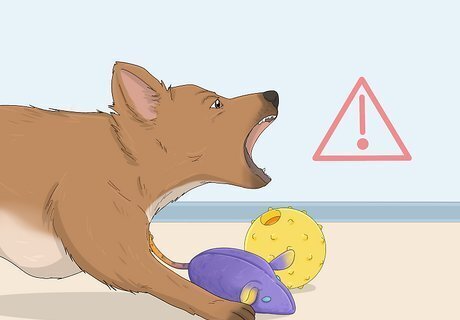
Hide toys when another dog is around. If your dog becomes aggressive or territorial around their toys, you may need to hide or remove these toys when another dog is present. This will prevent your dog from becoming defensive over the toys, and it may allow them to play normally with the other dog.
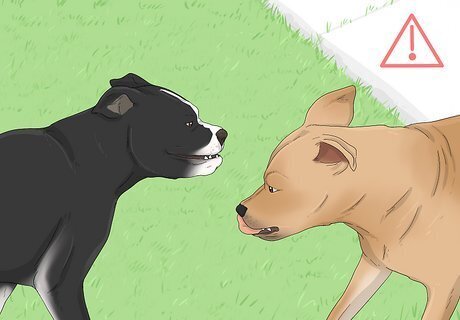
Separate dogs in a tense situation. If the dog is demonstrating aggressive behavior or if it seems that they are about to engage in a fight, get your dog away as soon as possible. If your dog is trained to respond to commands, use a “come” command or call their name. You may be able to distract the dogs by splashing them with a little bit of water. Do not grab the dog by the collar or front of the face, or you risk being accidentally bitten. Instead, if you absolutely have to handle the dog, grab the dog by the hindquarters.
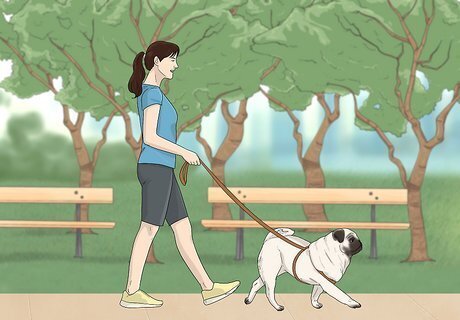
Avoid tricky situations. If your dog repeatedly becomes aggressive during play, you may need to remove them from the situation when it arises. You can prevent these situations by placing the dog in a separate room if there is a strange dog in the house. You may also need to avoid dog parks. You can take your dog on a leashed walk instead or play with them in an enclosed yard.


















Comments
0 comment